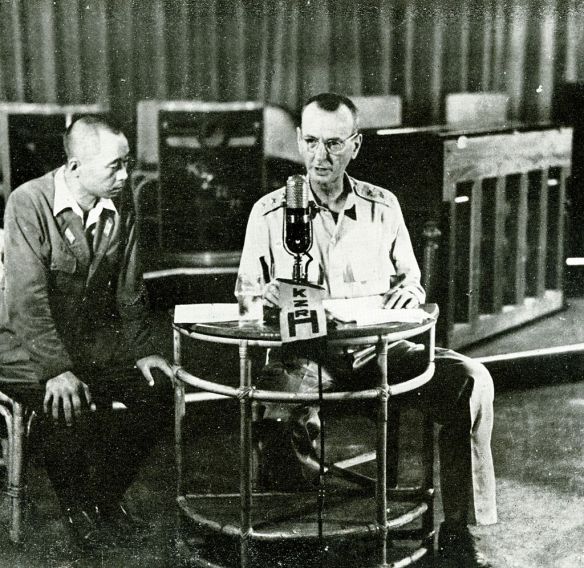
Wainwright ordering the surrender of the Philippines and watched by a Japanese censor.
Jonathan Mayhew Wainwright (1883-1953) commanded the American forces in the Philippines during World War II. He became a world symbol of resistance to the Axis in the siege of Corregidor and during four years in Japanese captivity.
Jonathan Wainwright was born on Aug. 23, 1883, in Walla Walla, Wash., the son of a career Army officer. A solemn young man, Wainwright graduated from the U.S. Military Academy in 1906. He served in the cavalry in Texas and the Philippines. In World War I he was a member of the general staff of the 82d Division and saw action in Europe.
Wainwright attended the Army’s postgraduate schools and advanced to the rank of major general. In October 1940 he went to the Philippines to help Gen. Douglas MacArthur prepare the American colony for the expected Japanese invasion. A shortage of funds, however, meant few improvements, and when war came on Dec. 7, 1941, the Americans and the Philippine troops were woefully unprepared. The Japanese caught their B-17 bombers on the ground at Clark Field and destroyed them, making the defense of the islands hopeless. The Japanese landed on the major island of Luzon on December 10 and by early January 1942 had forced Wainwright, commanding the North Luzon Force, to fall back to the Bataan peninsula.
The Navy, badly hurt at Pearl Harbor, dared not sail into Japanese-controlled waters to lift the siege. Wainwright continued to fall back. On March 12 he took command on Luzon. He moved his headquarters to the tiny island of Corregidor, at the mouth of Manila Bay, under constant Japanese artillery bombardment. On April 8 the pitiful remnants on Bataan surrendered, and Wainwright’s force of 11,000 men faced the vastly superior Japanese alone.
Manila harbor was a key strategic point in Japanese offensive plans, so they committed major forces to Wainwright’s destruction. Except for an occasional submarine, no supplies reached Wainwright. He and his men suffered terribly but held out for nearly a month. Finally, on May 5, 1942, Wainwright wired MacArthur: ‘‘As I write this we are being subjected to terrific air and artillery bombardment and it is unreasonable to expect that we can hold out for long. We have done our best, both here and on Bataan, and although we are beaten we are still unashamed.’’ That night the Japanese landed on Corregidor, and at noon the next day Wainwright initiated surrender negotiations.
Wainwright’s opponent, Gen. Homma, refused to accept the surrender of the garrison unless Wainwright ordered the remaining American forces on the southern Philippine islands to lay down their arms also. Desperate to avoid the annihilation of his troops on Corregidor, Wainwright complied. MacArthur, in Australia, was furious and ordered Wainwright’s subordinates to disregard the surrender order. They did not. MacArthur refused to agree to Gen. George Marshall’s recommendation of a Medal of Honor for Wainwright. ‘‘His animosity toward Wainwright was tremendous,’’ Marshall recalled later.
Wainwright had become America’s first World War II hero. The press gave the siege of Corregidor enormous coverage. In the prisoner-of-war camps Wainwright shared all his men’s privations and—often at great personal risk— intervened with his Japanese captors to try to obtain better treatment for the men. He was liberated in early September 1945; always a thin man, he now looked like a walking skeleton.
Congress awarded Wainwright the Medal of Honor in 1945. He retired in 1947, became a successful businessman, and died in San Antonio, Tex., on Sept. 2, 1953.
Further Reading Wainwright’s own account of the Philippine campaign and of his experience in prison are in General Wainwright’s Story (1946). By far the most competent account of the campaign is Louis Morton, The Fall of the Philippines (1953). Additional Sources Beck, John Jacob, MacArthur and Wainwright; sacrifice of the Philippines, Albuquerque, University of New Mexico Press 1974. Schultz, Duane P., Hero of Bataan: the story of General Jonathan M. Wainwright, New York: St Martin’s Press, 1981.